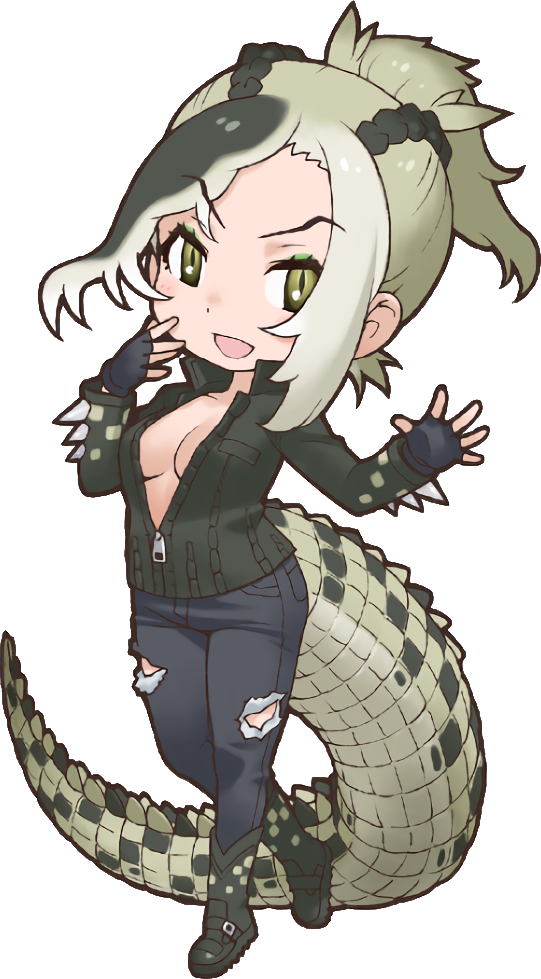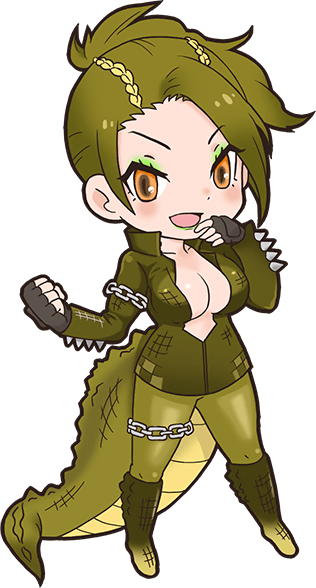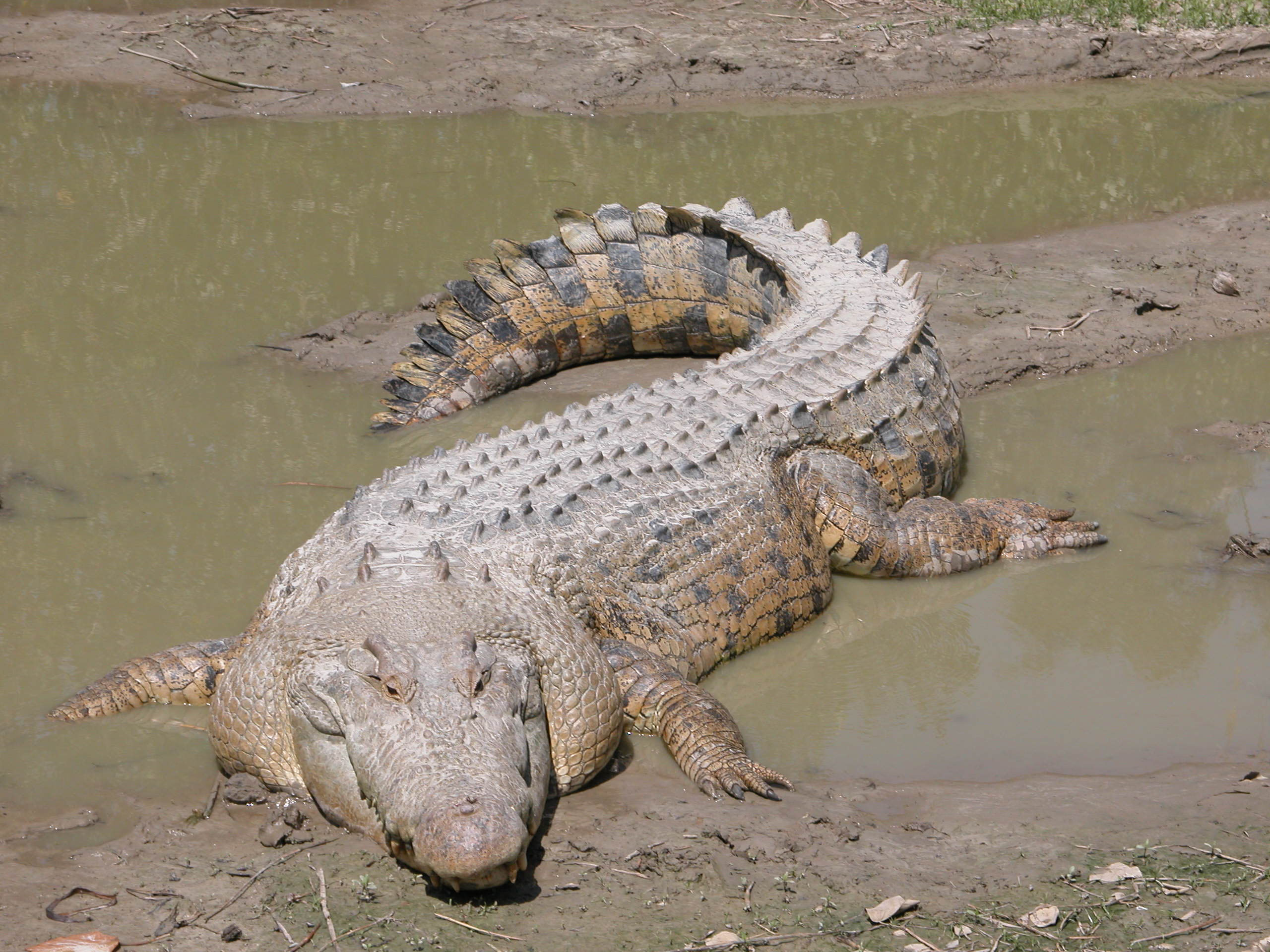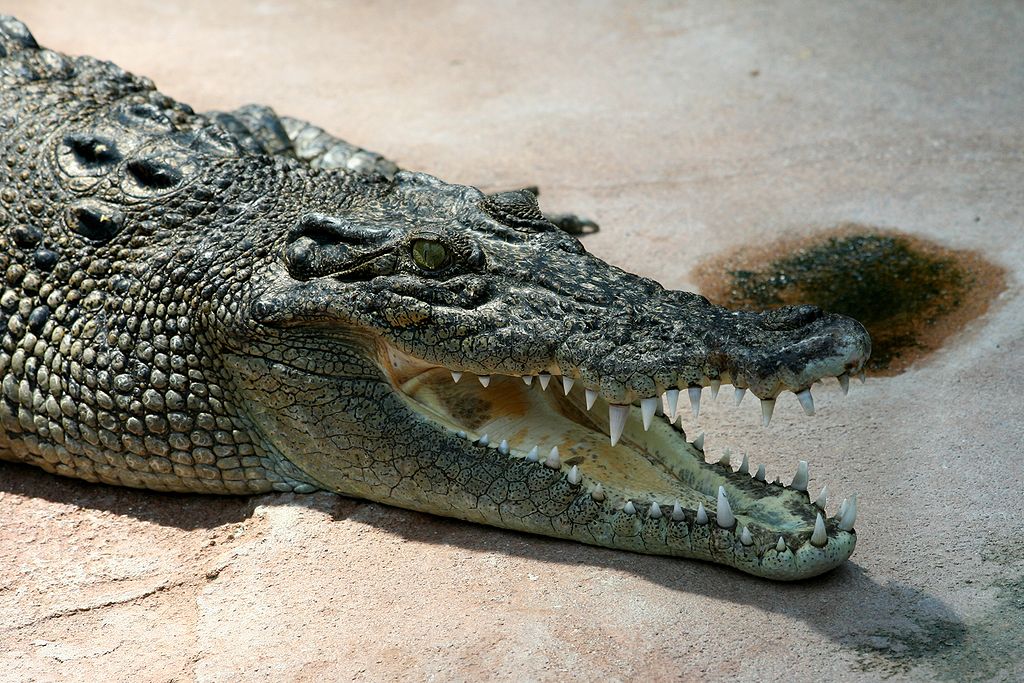
Saltwater Crocodile
(Redirected from Sea Crocodile)
Jump to navigation
Jump to search
| Saltwater Crocodile | |||
|---|---|---|---|
| イリエワニ | |||
| Character Data | |||
| AKA | Salt-Water Crocodile, Estuarine Crocodile, Indo-Pacific Crocodile, Marine Crocodile, Sea Crocodile, Saltie
| ||
| Romaji | Iriewani
| ||
| Debut | Kemono Friends (2015 Game) | ||
| Animal Data | |||
| Scientific Name | Crocodylus porosus
| ||
| Distribution | Southeast Asia, Oceania
| ||
| Diet | Carnivore
| ||
| Avg. Lifespan | 70 years
| ||
| Read More | Saltwater crocodile
| ||
| Conservation | 
| ||
| Saltwater Crocodile | Season 2 | Pavilion | KF3 | Kingdom | Nexon Game | Gallery |
“Because I like to live in bays and river deltas, I've become known as Saltwater Crocodile. Among any living reptiles today, I pride myself for having the largest body. Because with this special body, no matter who the opponent, with one blow I'll make them K.O.!”
—Saltwater Crocodile's introduction
Saltwater Crocodile is a crocodilian Friend that first appeared in the original Kemono Friends mobile game.
Appearance
Saltwater Crocodile has light green hair tied in a scruffy ponytail with two longer bangs on each side of her head that come down to her shoulders. She has a tuft of hair at the side of her head. She has black braids resembling scale ridges that go down each side of her head in an arc. Her left bang has a black patch and is much more scraggly than the rest of her hair, giving the impression of a crocodile's teeth. Her irises are green and she has sharp, angular eyebrows.
She wears a black biker jacket with white checkered spiky cuffs that match the pattern on her black boots. Her boots are V shaped at the tops and have buckled fasteners. She also wears blue jeans with pockets and rips at the side of each thigh. Her fingerless gloves match the color of her pants.
Her tail resembles that of her real life counterpart: thick, scaly, with black checker patterns, and lines of spines on the top.
Her original design had green hair with a short ponytail, two greenish braids and a long fringe on the front. Her skin is pale and her eyes are oranges with green eyeshadow. She wears a coat almost completely open with a high collar, four spikes on each sleeves and fingerless leather gloves. She wears tights in long boots. Most of her outfit is green with scales that are related to the animal on which it is based. Like the real animal, she bears a large green tail. As an extra, some chains surrounds her right arm and her right leg.
Series Appearances
| Media | Role | First Appearance | |
|---|---|---|---|
| 2015 | Nexon Game | ↪ Minor character, obtainable | |
| 2018 | Kemono Friends Pavilion | ↪ Minor character, encounterable | |
| 2019 | Kemono Friends 2 | ↪ Minor character, multiple episodes | S2E05: The Power of Humans |
| 2019 | Kemono Friends 3 | ↪ Minor character, obtainable | |
| 2022 | Kemono Friends Kingdom | ↪ Minor character, obtainable | |
In Real Life
Saltwater crocodiles are the largest reptile species alive today. Adult males can reach up to sizes of 6 to 7 meters. Females are much smaller and do not generally exceed 3 meters, with 2.5 meters considered large. The head is very large and a pair of ridges run from the eyes along the center of the snout. The scales are oval in shape and the scutes are small compared to other species. Saltwater crocodiles have a heavy-set jaw which typically contains up to 68 teeth, and no fewer than 64.
The saltwater crocodile shows a high tolerance for salinity, being found mostly in coastal waters or around rivers. It may also be found in freshwater rivers, billabongs and swamps. Movement between habitats occurs during the wet season, when juveniles are raised in freshwater rivers. However, these juveniles are usually forced out of these areas, by dominant males who use the freshwater areas for breeding grounds, and into areas of low salinity.
Saltwater crocodiles take a wide variety of prey, although juveniles are restricted to smaller items such as insects, amphibians, crustaceans, small reptiles and fish. When they become an adult, they feed on larger prey such as mud crabs, turtles, snakes, birds, buffalo, wild boar, and monkeys. Iconic for their opportunistic hunting strategy, they lurk patiently beneath the surface near the water's edge, waiting for potential prey to stop for a sip of water. However, they cannot eat their prey underwater as swallowing would allow water into their throat so they either have to drag their prey onto land or raise their head above the water to swallow. Humans are the main predators of saltwater crocodiles.
The saltwater crocodile spends most of its time idle, regulating its body temperature. If they become too hot they often go into the water with only their eyes and nostrils showing and stay submerged until they are cooled. If they become too cold, they lay in the sun on flat rocks until they warm up. Their legs are held flat against their body or slightly out to the side while they swim because all of their propulsion comes from their tail. They can also leap out of the water from a stationary position at the water's surface. It is more effective in deeper water as the crocodile can position its body better in order to get maximum propulsion from its tail. The saltwater crocodile has been thought of as one of the most intelligent and sophisticated of all reptiles. Their barks are a way of communicating with one another. The saltwater crocodile is thought to have four different calls. One is the distress call, which is normally only performed by juveniles. This call is higher pitched than most other calls and consists of short barks. They are also thought to have threat calls in which C. porosus makes a hissing or coughing sound at its intruder. There is also the hatching call. This call is only performed by newborns and is only one, short bark, high in tone. There is also the courtship bellow, which is a long, low growl.
Trivia
Animal Trivia
- The saltwater crocodile can travel over a thousand kilometres by sea but needs dry land to reproduce.
- Because of its broad body and the low number of armor plates on the neck, the saltwater crocodile was initially believed by some to be an alligator rather than a true crocodile. It is still sometimes referred to as a gator in Australia, and the Alligator Rivers are named after this species.
- The scientific name Crocodylus porosus is an allusion to the rugged and bumpy upper surface of the snout seen in large adult specimens. Porosus means "full of callosities" and is derived from porosis, the Greek word for callosity, and osus, the Latin word for "full of".
- Saltwater crocodiles hold the record for the highest bite force ever recorded in any animal, with a peak bite force of 16,414 N (3,690 lbf), far surpassing the highest recorded value in the spotted hyena of 4,500 N (1,012 lbf).
Friend Trivia
- The new Friend design for the Saltwater Crocodile bears a greater resemblance to its real life counterpart than the old design. The old design had more of a resemblance to stereotypical fictional depictions of crocodiles and alligators, which are often greener than the actual animals. Examples include Tick-Tock from Peter Pan, King K. Rool from Donkey Kong, Vector from Sonic the Hedgehog, and the University of Florida football mascots, Albert & Alberta Gator.
References
- "Crocodylus porosus". Animal Diversity Web.
- Saltwater Crocodile facts. Aquaticcommunity
- Saltwater Crocodile. The Animal Files
| Reptile Friends | |||||
|---|---|---|---|---|---|
| Crocodilia | |||||
| American Alligator • Gharial • Saltwater Crocodile • Spectacled Caiman | |||||
| Lizards | |||||
| Chinese Water Dragon • Frilled Lizard • Jackson's Chameleon • Komodo Dragon • Panther Chameleon • Satanic Leaf-Tailed Gecko | |||||
| Snakes | |||||
| African Rock Python • Amazon Tree Boa • Black Mamba • Boomslang • Coastal Taipan • Emerald Tree Boa • European Ratsnake • King Cobra • Okinawan Habu • Tsuchinoko | |||||
| Turtles | |||||
| Alligator Snapping Turtle • Galápagos Tortoise • Genbu • Indian Star Tortoise • Leopard Tortoise • Red-Eared Slider • Red-Footed Tortoise | |||||



